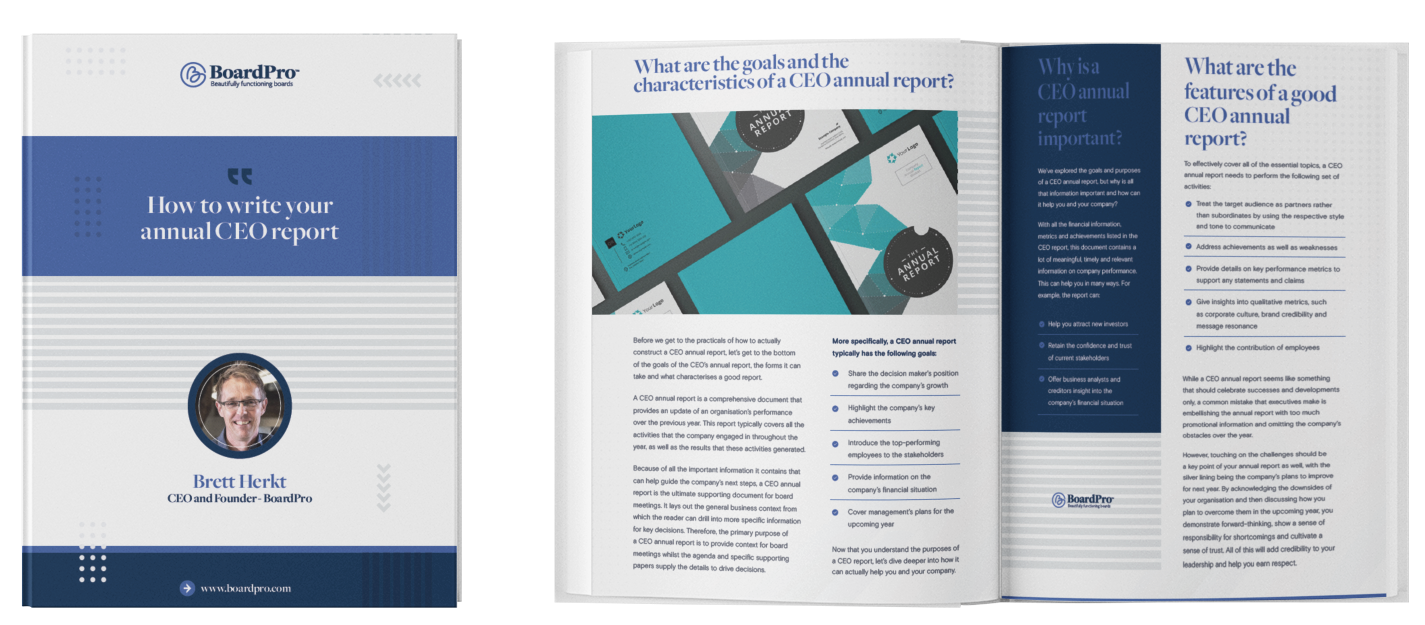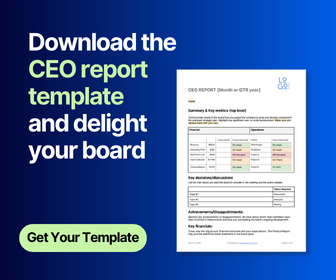The process of writing your CEO annual report starts way in advance before you begin actually drafting the report. This is because with so much going on in the business, the reality is, you should already be continuously keeping track of your organisation’s metrics and results throughout the year, and then using the annual report as an opportunity to include all this information in a final message.
So, because it will soon be time to start preparing your CEO annual report, let’s take a closer look at all the components it should include.
What are the goals and the characteristics of a CEO annual report?
Before we get to the practicals of how to actually construct a CEO annual report, let’s get to the bottom of the goals of the CEO’s annual report, the forms it can take and what characterises a good report.
A CEO annual report is a comprehensive document that provides an update of an organisation’s performance over the previous year. This report typically covers all the activities that the company engaged in throughout the year, as well as the results that these activities generated.
Because of all the important information it contains that can help guide the company’s next steps, a CEO annual report is the ultimate supporting document for board meetings. It lays out the general business context from which the reader can drill into more specific information for key decisions. Therefore, the primary purpose of a CEO annual report is to provide context for board meetings whilst the agenda and specific supporting papers supply the details to drive decisions.
More specifically, a CEO annual report typically has the following goals:
- Share the decision maker’s position regarding the company’s growth
- Highlight the company’s key achievements
- Introduce the top-performing employees to the stakeholders
- Provide information on the company’s financial situation
- Cover management’s plans for the upcoming year
Now that you understand the purposes of a CEO report, let’s dive deeper into how it can actually help you and your company.
Why is a CEO annual report important?
We’ve explored the goals and purposes of a CEO annual report, but why is all that information important and how can it help you and your company?
With all the financial information, metrics and achievements listed in the CEO report, this document contains a lot of meaningful, timely and relevant information on company performance. This can help you in many ways. For example, the report can:
- Help you attract new investors
- Retain the confidence and trust of current stakeholders
- Offer business analysts and creditors insight into the company’s financial situation
Fundamentally, however, every business’s goal is to continue growing and developing. And a CEO report offers all the key information that you need so that your partners and stakeholders are on the same page regarding the direction the company is heading towards.
What are the features of a good CEO annual report?
To effectively cover all of the essential topics, a CEO annual report needs to perform the following set of activities:
- Treat the target audience as partners rather than subordinates by using the respective style and tone to communicate
- Address achievements as well as weaknesses
- Provide details on key performance metrics to support any statements and claims
- Give insights into qualitative metrics, such as corporate culture, brand credibility and message resonance
- Highlight the contribution of employees
While a CEO annual report seems like something that should celebrate successes and developments only, a common mistake that executives make is embellishing the annual report with too much promotional information and omitting the company’s obstacles over the year.
However, touching on the challenges should be a key point of your annual report as well, with the silver lining being the company’s plans to improve for next year. By acknowledging the downsides of your organisation and then discussing how you plan to overcome them in the upcoming year, you demonstrate forward-thinking, show a sense of responsibility for shortcomings and cultivate a sense of trust. All of this will add credibility to your leadership and help you earn respect.
What are the typical annual report formats?
You can deliver a CEO annual report in the following formats:
- Printed. Physical copies of the report can be, and are often distributed among the shareholders, media members, sometimes among the government officials and for PR purposes.
- Digital. A digital copy can be uploaded to the company’s website. It can also be shared via the company’s social platforms, such as LinkedIn.
- Interactive. Although this format is more rare, an interactive copy can come in the form of a scannable e-book. It can even have its own landing page containing videos, interactive charts and infographics.
To select the optimal format for your report, consider your target audience of the report and how you usually communicate with them. And then you can begin building your report from there! So let’s take a closer look at how to write a good annual report.
How do you write a comprehensive CEO annual report?
1. Begin by figuring out the audience to address
CEO annual reports usually focus on one or both of these audiences: employees and stakeholders.
The choice of the target audience for your annual report will impact its structure. For instance, if your report is intended for your employees, you can omit the nitty gritty financial details.
On the other hand, a financial report is a must-have if your annual report targets stakeholders. However, the annual report should comply with the requirements imposed by your government’s regulatory body to ensure that you do not share sensitive financial information.
2. Review important events and milestones
We started this whitepaper by touching on the importance of tracking key achievements, metrics and milestones throughout the year. That’s because this information will be vital for constructing your report. So once you have gathered all this information and given these events one final overview to make sure you haven’t missed anything, you are ready to begin the body of your report.
At this point, you can list your achievements in a few different ways:
- Monthly. Outline the achievements that characterised each month of the past year.
- By milestones. Mention all milestones and the achievements associated with them.
- By individual achievement. Mention the names of the employees or teams and their individual successes.
The format you choose will most likely depend on your organisation’s milestones and achievements, so select a format that fits your business progress and achievements best.
Reporting successes by individual achievement is great if you want to boost employee morale and recognise your employee’s achievements. But in general, regardless of the format you choose, you should still try to mention the names of the employees who have contributed the most to your company’s success over the past year.
How long should the events and milestones section be?
A CEO annual report can list the major achievements in the introduction right after addressing the target audience. This part should be short and concise. A longer version with all the details on these achievements will usually be described in the business profile section.
3. Outline the business profile
Also known as the business performance overview, the business profile section of a CEO annual report touches on the company’s mission statement, details about the board of managers, employees and the products or services that are the main sources of revenue.
As mentioned previously, the business profile part should also provide details on the key milestones and how they were (or were not) accomplished. At this point, it is recommended to dedicate one paragraph of this section to different milestones to organise the text clearly for the readers.
Try to mention one milestone per paragraph, and it’s fine and normal if they come out a bit long (as you can see in the example above). That said, make sure your text is still readable. Try to write shorter sentences, and check the overall readability with an online writing service once you are done. Hemingway or Grammarly are good ones to use.
Apart from the highs, the business profile section should also include the lows, such as every underachievement and goal that your company failed to accomplish over the past year. This information is especially important for the stakeholders because it helps them better understand whether the company needs more resources to accomplish these goals.
When describing the missed goals, you should focus on:
- The initial intent behind these goals
- Why you failed, such as lack of resources, not enough time etc.
- How you plan to achieve these goals in the upcoming year
To avoid baseless claims, be sure to support your plans with some real-life data. Also, keep in mind to show that you are open to suggestions from your employees or stakeholders.
4. Provide a financial overview
The next step in writing a CEO annual report in drafting the financial overview. This information in the report depends on whether the company is public or private. If your report is intended only for your employees in your private company, you can largely skip this part.
However, if your report addresses the shareholders, it should include a statement on the financial overview of the past year. This section needs to be accurate with thorough reporting and transparency. All information needs to be based on specific real-life data.
The financial overview part usually has the following structure:
- Income statement
- Company balance sheet
- Equity statement
- Cash flow statement
- The statement with earnings per share
- The market price of your company shares
Additionally, the financial overview section can also include the auditor’s report on the company’s current financial state and the analysis of future growth.
5. Conclude with the outlook for the future
Lastly, it is always important that you end your CEO annual report on a positive note. Share some prospects and plans for the future. And, feel free to break down this section according to the milestones you intend to reach this upcoming year.
In this section, it is salient to focus on what you plan to do next based on what has already been done to lay the groundwork for these upcoming milestones.
At this point, make sure to support your plans with clear evidence. For example, using the data that justifies the milestones you have set to achieve will be helpful information.
Finally, you can conclude your CEO annual report with an ending message that summarises the statements and claims you have made. Here, it is important to maintain the same style throughout the report. Always be realistic rather than overly optimistic.
Once you have all the information you need to discuss in the report, you can insert a list of all your references if you included any in your report. Your stakeholders may find it helpful so as to take a closer look to better understand the reasoning behind your statements.
Writing a CEO annual report: Topic recap
Preparing a CEO annual report is a lot of work. You have to start preparing for it way in advance to collect all the necessary data and to make sure all the milestones are included.
Hopefully, this guide will help you when you are writing your annual report. But if you are in a hurry, here is a quick recap of all the tips for you:
- Determine your target audience. Choose and address whether your report will focus on employees or stakeholders. This choice will determine the structure of your report (e.g., whether a financial overview will be there or not).
- Review important events and milestones. Include all the milestones you did and didn’t achieve to provide a realistic picture of your company’s accomplishments.
- Outline the business profile. Introduce your business, its key players and include a more detailed overview of all the milestones.
- Provide a financial overview. If your report is intended for the stakeholders, share data-based financial information and keep your overview transparent.
- Conclude with the outlook for the future. Describe the milestones you are planning to achieve and what has already been done to successfully complete them.
Finally, watch the style of your report and keep it consistent. It should not be too promotional or overly optimistic. Instead, your report should give realistic expectations with real-life data to support your statements.
If you're looking for a tool to streamline your Board processes, check out BoardPro - an all-in-one software solution designed specifically for Boards and busy CEOs!
Schedule a demo with our team today and begin to experience a whole new way of meeting.
Share this
You May Also Like
These Related Stories

The importance of CEO reports in an organisation

Create your annual CEO report




